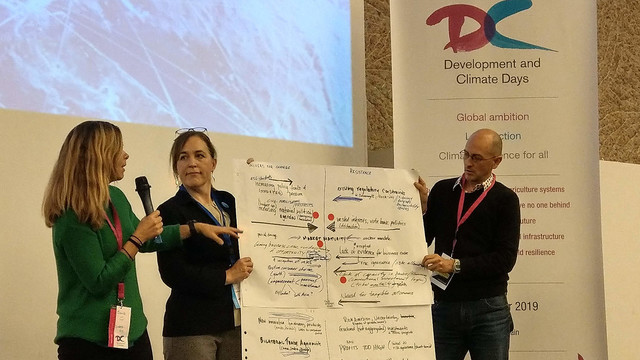Acting on the planetary emergency
With evidence of grave ecological and social crises mounting, director Andrew Norton considers the scale and shape of the challenges ahead and how IIED can step up action to meet them.


A student climate strike in Jakarta, Indonesia. Social movements are among those voicing alarm at the climate crisis (Photo: 350.org, Creative Commons via Flickr)
Warnings on the climate emergency have rung out clearly over the last year, voiced by social movements such as Extinction Rebellion and the worldwide school strikes; by scientists documenting the alarming acceleration of planetary warming; and by social scientists, activists and journalists bearing witness to great suffering in many parts of the world – most often those nations least culpable for climate change.
Threats coming into sharp focus
The shape of the planetary emergency becomes ever clearer. A succession of IPCC reports – on 1.5°C of warming, on impacts on land and on oceans and the cryosphere – have hammered home the alarming peril for human society and the natural world.
The report on 1.5°C starkly states the importance of meeting this target, particularly for the most climate-vulnerable people and places, while warning that – if emissions continue at present scale – global warming may well hit this level as early as 2030.
Calling for ‘rapid and far-reaching transitions in energy, land, urban and infrastructure and industrial systems’, the IPCC notes that the actions required to stay within 1.5°C of warming are unprecedented in terms of scale in the timeframe required. Business as usual is not an option if we wish to avoid catastrophic changes to the natural and human world.
This is before we even factor in uncertainties such as the potential carbon release from the thawing of Arctic permafrost.
April’s Intergovernmental Science-Policy Platform on Biodiversity and Ecosystem Services (IPBES) report highlighted the parallel threat of biodiversity loss, driven by climate change and a storm of other factors including pollution and shifts in land usage. One million animal and plant species are at risk of extinction and more than a third of all marine mammals are threatened.
This in turn endangers the wellbeing of large numbers of the world’s poorest people, who are disproportionately dependent on their local land- and seascapes for resilience, disaster protection, income and nutrition.
The threats are manifold. The United Nations estimates that climate disasters are occurring at the rate of one per week, with the vast majority of those killed living in the world's poorest nations.
And after decades of decline, the number of men, women and children suffering from hunger and undernourishment rose by 40 million in just two years, driven by a sharp increase in sub-Saharan Africa. This unwelcome reversal is due at least in part to the climate emergency.
Developing our response
We cannot afford to be paralysed by the scale of what we face. IIED’s new five-year strategy is built around a proactive response to five inter-locking global challenges: growing inequality, the climate crisis, the assault on the natural world, unsustainable markets and increasing urban risk.
The strategy is a statement of our engagement with the global state of social and ecological crisis. In recognition that we are dealing with a moving target, and that there is no time to lose, our approach is agile enough to respond quickly to the changing shape of the challenge, and the opportunities we see for IIED to make a difference.
Over the coming months, we will strengthen our existing response by:
- Further reducing our ecological footprint: despite a flight-heavy business model, IIED has been a sector leader in setting and meeting reduction targets; in 2018 we cut our carbon footprint by 12%. But it is clear from the increasing evidence of impending ecological collapse, changing public norms, and staff commitment to climate action and environmental stewardship, that we must do more. An internal review in January 2020 will seek ways to cut our carbon footprint even more, while still delivering our critical work.
- Bringing evidence of the human cost into public debate: IIED’s experience of working on climate resilience and biodiversity loss in the most vulnerable low-income communities and countries means we can – and should – highlight the human dimensions of climate justice in graphic terms. We have always worked to bring marginalised voices into decision-making forums, from local to global, and can take this wider.
- Reviewing our knowledge of effective mobilisation for social change to support global climate action: we will revisit our years of ‘making change happen’ to ensure our knowledge – and the questions it poses – are accessible to social movements. We begin with series of blogs in early 2020, themed ‘mobilising for climate justice’. We will include both IIED and partner perspectives, including the remarkable experiences of working with Slum/Shack Dwellers International over many years. SDI, a federation of people living in informal settlements, is active in more than 30 countries working from the ground up.
- Dig deeper to explore climate justice in all its dimensions: as we embed this in all our analytic and operational work, we will continue to work to promote effective actions for a just transition to a fairer and more sustainable world. An outstanding example is our work with the Least Developed Countries’ (LDCs) Initiative for Effective Adaptation and Resilience (LIFE-AR). This initiative supports LDCs to develop their own vision of a climate-resilient, low-carbon future and directs them to resources that can help realise their ambitions.
We will also be working throughout 2020 to seize opportunities to keep encouraging development actors to recognise and act on biodiversity loss as an inherent element of their work.
As we work to increase our impact through the activities listed above, we are keen to develop active partnerships and learn from the experience of others. If you are interested in working and learning with us, please get in touch.



